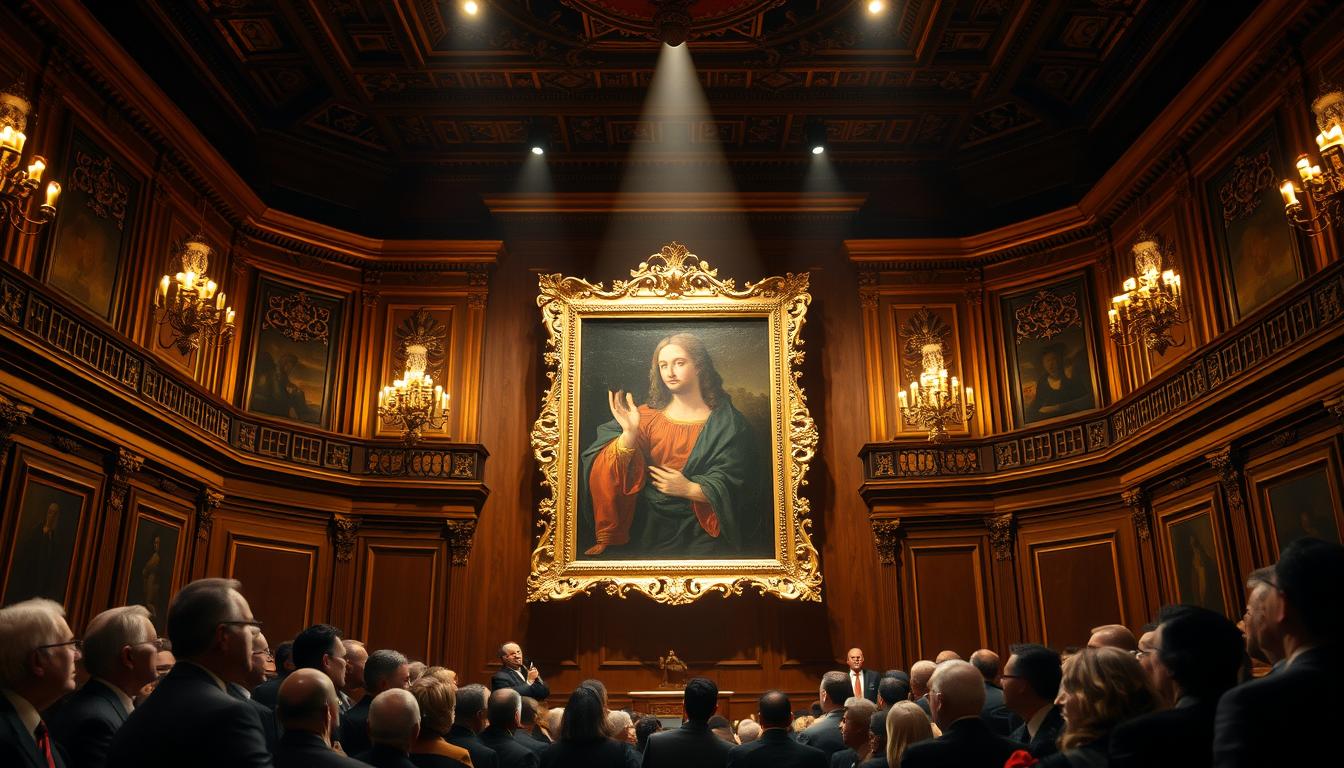On November 15, 2017, at Christie’s in New York, Leonardo da Vinci’s Salvator Mundi sold for a staggering 450 million plus result after an intense bidding war. An 18-minute sequence and a dramatic jump bid stunned everyone in the room and reshaped art market records.

The work’s journey to that evening included heavy restoration, a high-profile National Gallery exhibition, and debate led by a noted curator. Major museums had declined to acquire it, yet the sale campaign broadened interest beyond typical auction circles.
This intro previews the core questions that linger years later: who was the actual buyer, why did this picture spark heated debate, and what did the price say about power and taste? That saga became front-page news and kept experts and the public talking for many years.
Key Takeaways
- The 2017 auction at Christie’s set a new record and drew global attention.
- Marketing, exhibition placement, and restoration played key roles in shaping value.
- Scholarly debate over attribution and condition amplified public interest.
- The buyer’s identity and motives raised broader questions about influence in art.
- The sale illustrated how museums, advisers, and media can shape a work’s fate.
Breaking: Saudi crown prince identified as buyer of Leonardo’s Salvator Mundi
New reports tied an anonymous phone bid to senior Saudi leadership, reframing the auction as geopolitical theater.
U.S. intelligence assessed that mohammed bin salman, crown prince of saudi arabia, was the ultimate buyer. Officials say the bid came through a proxy.
Reporting by the new york times detailed that prince Bader submitted a $100 million deposit before the sale and placed the final phone bid. Later intelligence pointed to bin salman as the principal.
Christie’s announced the work would travel to louvre abu dhabi, and the museum in abu dhabi publicly confirmed arrival plans. The timing followed a major anti‑corruption campaign at home.
| Element | Detail | Implication |
|---|---|---|
| Proxy bidder | Prince Bader’s deposit and phone bid | Proof of funds for a trophy acquisition |
| Intelligence | Assessment naming bin salman | Links sale to state influence |
| Museum plan | Louvre Abu Dhabi tweet | High-profile regional display |
"The identification turned a market mystery into a wider story about culture and power."
Inside the record Christie’s New York sale and the hype that fueled $450.3 million
An 18-minute bidding marathon in New York turned an Old Master into a global moment of spectacle.
The bidding war stretched over phone lines and live seats. Specialist phones were manned as bids climbed. One shock $400 million jump bid vaulted offers and drew audible gasps from people in the room.
Christie New York placed Salvator Mundi in a Post‑War and contemporary art evening sale to broaden demand. That cross-category move pushed curiosity from multiple collector pools and changed how houses stage blue-chip lots.
The marketing lift
Christie’s hired Droga5 to brand the lot as “The Last Da Vinci.” A global multimedia campaign and a prior National Gallery exhibition gave curatorial backing and primed buyers.
| Element | Action | Impact |
|---|---|---|
| Placement | Post‑War & Contemporary sale | Expanded bidder pool |
| Branding | Droga5 campaign | Heightened scarcity and desire |
| Provenance boost | National Gallery exhibition | Curatorial validation |
"The auction's choreography and timing created urgency that turned interest into record offers."
For a detailed contemporary report on that evening, see this auction recap.
Who bought the $450 million dollar painting? Tracing the winning bid to Mohammed bin Salman
Reporting and intelligence combined to point a clear line from a late phone bid to a royal figure. Documents show Prince Bader bin Abdullah bin Mohammed bin Farhan al‑Saud posted a $100 million deposit the day before the sale and then placed the final phone bid in New York.
U.S. intelligence assessed that Prince Bader acted as a proxy for mohammed bin, identifying bin salman as the ultimate buyer. That assessment relied on banking records and witness accounts of how bids moved across specialist phones during the auction.

Proxy and phone bid details
Prince Bader’s deposit met a threshold needed to access high‑stakes auction lines. Multiple phone lines and auction specialists made anonymity possible. For more on the proxy mechanics, see this detailed report.
Where it was headed next
Christie’s announced a planned display at louvre abu dhabi, and the museum confirmed arrival via tweet. That public step tied the sale to regional cultural strategy and to rivalry with nearby states that had earlier declined offers for the work.
"A single museum announcement can reset expectations about access, scholarship, and future loans."
- Proxy bid: $100 million deposit and a final phone bid by Prince Bader.
- Intelligence link: Assessments tracing funding and motive to crown prince leadership.
- Museum path: Louvre Abu and Abu Dhabi confirmations shaped the work’s public future.
From $45 to $450 million: provenance, restoration, and authenticity questions
From a £45 lot in 1958 to global headlines, the salvator mundi’s history spans decades of mystery and debate.
Provenance timeline
In 1958 Sotheby’s London sold a misattributed work for £45. Years later, in 2005, it surfaced in Louisiana. Accounts vary: one report lists a $10,000 local sale; another notes a $1,175 online purchase in New Orleans.
Restoration and debate
A conservator, Dianne Dwyer Modestini, removed heavy overpaint and rebuilt lost passages. That conservation shaped how scholars viewed the work. Still, some critics suggested a different hand, naming Bernardino Luini.

Institutions and market ripples
Major museums—including Getty, MFA Boston, Gemäldegalerie Berlin, and the Hermitage—declined to acquire it before 2013. That refusal affected later sales strategy.
| Year | Event | Impact |
|---|---|---|
| 1958 | Sotheby’s sale (£45) | Misattribution, low interest |
| 2005 | Louisiana/New Orleans purchase | Restoration funded, attribution revived |
| 2013 | Private flips ($80M → $127.5M) | Legal and market scrutiny |
| 2011–12 | National Gallery exhibition | Curator endorsement boosted attention |
| 2017 | November sales | Strong Asian bidding; guarantor gains reported |
"Conservation, provenance, and private sales together turned questions about attribution into a major market story."
- Summary: Years of patchy records, bold restoration, and market engineering combined to propel a disputed leonardo vinci attribution into public view.
Conclusion
After months of reporting and review, U.S. intelligence identified mohammed bin salman as the buyer tied to the record sale at Christie’s New York. That revelation gave context to a once‑mysterious phone bid and to plans to exhibit the work at louvre abu dhabi.
The journey from obscurity to global news combined restoration, bold marketing as “The Last Da Vinci,” and intense auction choreography. The image—Christ’s blessing hand and the clear orb—became shorthand in debates about authorship, conservation, and cultural meaning.
Interest endures. Watch for museum updates, new conservation reports, and market signals that could reshape views on the leonardo vinci salvator. For background on provenance and display history, see Salvator Mundi.
Enhance Your Space with Unique Modern Masterpieces
Are you inspired by the innovative mediums and conceptual depth highlighted in our exploration of contemporary art? You’re not alone! Today’s art enthusiasts are seeking cultural relevance and emotional connections in their artwork. However, finding pieces that resonate with modern themes and fit your unique style can be a challenge. That’s where we come in!
At Rossetti Art, we specialize in canvas prints, original paintings, and modern sculptures that celebrate the spirit of now. Each piece created by Chiara Rossetti brings a personal touch that connects deeply with current social narratives—just like the modern masterpieces discussed in the article. Don’t miss out on the chance to elevate your home decor with breathtaking artwork that speaks to your values and aesthetic. Explore our collection today and find your perfect piece! Act now, and transform your space into a gallery of inspiration!
FAQ
Who purchased Leonardo’s Salvator Mundi at Christie’s New York?
Multiple reputable news outlets and U.S. intelligence reports trace the winning bidder to Saudi Crown Prince Mohammed bin Salman, acting through intermediaries.
How did the sale at Christie’s reach $450.3 million?
A dramatic 18-minute bidding duel, aggressive guarantees and pre-sale marketing combined with intense collector interest and a surprise jump in offers pushed the final hammer to $450.3 million.
What role did Christie’s marketing play in the result?
Christie’s framed the work as a rediscovered Leonardo and dubbed it “The Last da Vinci,” staging global exhibitions that amplified hype and drew high-net-worth bidders and institutions into the chase.
Were proxies or phone bids used in the winning transaction?
Yes. Reports indicate the sale involved proxies and phone bidding. Prince Bader of Saudi Arabia reportedly placed a deposit, and other intermediaries acted on behalf of the eventual owner.
Did Louvre Abu Dhabi announce plans to display the painting?
After the sale, announcements linked the work to Louvre Abu Dhabi exhibitions, reflecting diplomatic and cultural ties between Abu Dhabi and Saudi interests in showcasing major works.
What is the painting’s provenance before the 2017 sale?
The provenance spans decades: a 1958 Sotheby’s misattribution, a 2005 Louisiana purchase labeled a “sleeper” work, subsequent scholarly re-evaluation, and restoration that culminated in its Christie’s appearance.
Who restored the painting and why does that matter?
Conservator Dianne Modestini led the restoration. Her interventions and the extent of retouching fueled debate about attribution, original material, and how restoration affects value and authenticity.
Which institutions declined to acquire the work prior to the auction?
Major museums—including the Getty, the Museum of Fine Arts Boston, Berlin collections, and the Hermitage—either passed on acquisition opportunities or did not endorse authentication, impacting public trust and market dynamics.
How did this sale change auction strategy and the Old Master market?
The record result reset expectations, encouraged bigger guarantees, and blurred lines between Old Master and contemporary markets, prompting advisers to adopt more aggressive bidding tactics and marketing playbooks.
What involvement did international politics and intelligence reports have in identifying the buyer?
U.S. intelligence disclosures and investigative reporting helped link the winning bid to Saudi actors, showing how high-end art transactions can intersect with state-level diplomacy, cultural initiatives, and political scrutiny.
Did the sale influence markets in Asia and the Gulf?
Yes. The high-profile result energized collectors in Asia and the Gulf, increased competition for marquee works, and highlighted the growing influence of regional museums and private buyers in shaping the global market.





Leave a comment
This site is protected by hCaptcha and the hCaptcha Privacy Policy and Terms of Service apply.